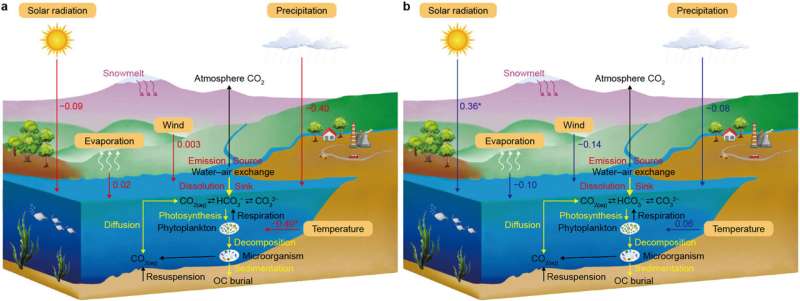This article has been reviewed according to Science X's editorial process and policies. Editors have highlighted the following attributes while ensuring the content's credibility:
fact-checked
proofread
Shifts in lake carbon dynamics on the Qingzang Plateau: From predominant carbon sources to emerging carbon sinks

A new study shows that annual carbon emissions from lakes in the Qingzang Plateau (QZP)—a vast elevated plateau at the intersection of Central, South, and East Asia—have declined, with some lakes shifting from carbon sources between 1970–2000 to carbon sinks between 2000-2020, a finding that has implications for estimates of global warming and climate change relative to China overall.
The study was published in Environmental Science and Ecotechnology, and offers insights into the timing and degree of shifting in the annual CO2 flux for lakes in the QZP region.
The authors found that the QZP lake systems have generally acted as a carbon source from 1970–2000, with an annual CO2 exchange flux of 2.04 ± 0.37 Tg C yr−1. From 2000 to 2020, some freshwater and saltwater lakes shifted from acting as a carbon source to a small carbon sink, while the annual CO2 exchange flux of QZP lakes has decreased to 1.34 ± 0.50 Tg C yr−1.
Before 2000, the average temperature on the QZP from 1970 to 2000 was lower, aquatic plant and phytoplankton rates were relatively low, and the effect of respiration on C emissions was more pronounced. After 2000, the annual average temperature on the QZP showed a rising trend.
At the same time, the CO2 absorbed through photosynthesis exceeded the CO2 released through respiration, while pCO2 at the water-air interface decreased, and waterbodies increasingly become less saturated, all of which are conducive for CO2 entering waterbodies.
On the QZP, most lakes are located above an altitude of 3000 m, with low levels of eutrophication. Phytoplankton and aquatic macrophytes are very sensitive to the availability of light, and a slight reduction in solar radiation will also slow respiration processes and gradually decrease CO2 emissions.
In addition, solar radiation is crucial in carbon emissions during lake ice melting. When the lake ice begins to melt in the spring, the circulation (flipping) of the water column caused by convection causes a significant outflow of CO2.
In recent decades, the annual solar radiation on the QZP has generally declined, which will weaken the convection in the water body and thus reduce CO2 emissions.
Since the turn of the 21st century, the expansion rate in the lake area has accelerated due to increased precipitation and glacial meltwater, providing a broader living space for aquatic plants and phytoplankton growth. Due to increased river runoff, QZP lakes have received more nutrient inputs, increasing aquatic plant and phytoplankton biomass.
This lake area expansion has also decreased lake salinity levels, reducing aquatic plant and phytoplankton toxicity stress. Moreover, aquatic plants and phytoplankton have absorbed more CO2 from the atmosphere through photosynthesis, which has increased carbon fixation.
These factors have collectively contributed to a decrease in QZP lake carbon emissions over the past five decades. This trend suggests that QZP lakes might assume an increasingly significant role in both regional and global carbon cycles in the context of ongoing global climate change.
More information: Di Shen et al, Decadal shifts in Qingzang Plateau lake carbon dynamics (1970–2020): From predominant carbon sources to emerging sinks, Environmental Science and Ecotechnology (2024). DOI: 10.1016/j.ese.2024.100389
Provided by Eurasia Academic Publishing Group




















